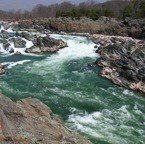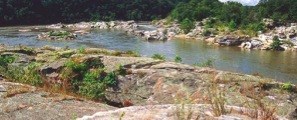
Flashy hydrology? Bouldery bars and groundwater infiltration? These might sound like lyrics to a hip-hop song or the names of cocktails, but they tell us what happens on the land influences the Potomac and its tributaries. When scientists talk about hydrology, they refer to how water circulates on and under the ground. As rain falls to Earth, it either soaks, or infiltrates, into the ground or it drains quickly into small streams, also called tributaries. In mountainous regions of the upper Potomac, upstream from the Gorge, soils are impervious to water. For various reasons, rainfall does not soak into the ground. It races to the nearest stream. These "flash floods" quickly build the volume of water entering the Potomac. At Great Falls after a storm, the Potomac is ripping because of all that run-off upstream. Paddlers love it! It’s the flashy hydrology upstream that gives the Gorge its high water after storms. All that water acts like a power washer on the riverbed and shoreline in the Gorge, scouring away vegetation and soil. It leaves behind bouldery bars on the shores and islands. These bars are especially evident in the lower Gorge. Willow trees, river birch and sycamores grow right out of the gravel. They are a distinguishing feature of the Gorge. Look for the sandbars and the vegetation they support on shoreline paths, such as the Billy Goat Trail. So you see how flashy hydrology upstream causes scouring floods, which leave the bouldery bars we see along the Potomac. What about in the small streams that feed the Potomac, especially in neighborhoods just outside the Gorge? Unlike the soils upriver, these soils do absorb water. But more and more ground near the Gorge is covered by parking lots, roads and building roofs. When rain falls on them, the water is shed quickly and races into small streams, scouring them and often destroying their natural configuration and biology. What can we do? We can modernize the way we deal with "stormwater." There are workable solutions. Some involve better planning and design. Others involve ideas like building new “green” roofs, which are covered with plants and soil that absorb water. In your own backyard, you can create a rain garden, so that the rain falling on your house waters the plants in your yard, rather than scouring a small stream. |
Last updated: April 10, 2015

